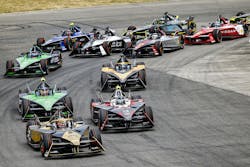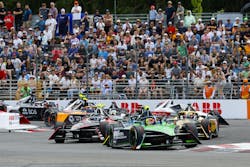Racing Into the Future: How the ABB Formula E Electric Racing Series is Driving EV Innovation
As the world races towards an electric future, companies driving the industry are emphasizing the need for innovation and simultaneous public education.
While these larger-than-life advancements seem suspended behind a velvet rope, the larger goal of electric vehicle (EV) innovation is to have these technologies – in one form or another – reach the hands of the everyday consumer and solve for a significant and ever-present portion of the climate crisis.
But how do these companies make technologies that are often entirely foreign concepts not only accessible but desirable by the public consumer at home or business.
As the ABB-sponsored Formula E electric race car series discovered, the answer lies in the world of elite sports.
“Elite sport reaches a global audience of billions every week. Athletes are among the most followed and influential people on the planet. Collectively, we have the potential to make positive changes for a more sustainable future and encourage fans to do the same. To use popular football manager parlance, we need to ‘give it everything,” said Jeff Dodds, CEO of Formula E.
Last month, Formula E hosted the 2024 Hankook Portland E-Prix racing event in Portland, Oregon. Teams from across the globe raced to take the top spot in the 13th round of the ABB FIA Formula E World Championship. Ultimately, the ABB-sponsored Porsche/ Tag Heuer driver Antonio Da Costa claimed the winning position during the Portland showcase.
EnergyTech Senior Editor Breanna Sandridge got an inside look into the Formula E electric racing world, which will see its final race of the season take place in London, to understand how this electric sport is taking the world by storm and creating an innovation playground for auto manufacturers to explore the potential of EVs and energy transition technologies.
What is Formula E?
In its simplest form, ABB FIA (the international federation for automotive racing) Formula E is an international racing series for electric racecars. However, its ultimate purpose is to create a testing ground for manufacturers to innovate and advance the technological capabilities of the electric auto industry while highlighting the benefits of EVs to encourage greater global adoption.
According to ABB, “Formula E is racing at the very limit of innovation, pushing the boundaries of EV technology and defining the future of motorsport… [while] giving manufacturers a technology testbed.”
In total, Formula E is host to 22 cars across 11 teams that feature some of the world’s largest manufacturers, including Nissan, Penske, Jaguar, Porsche, Maserati, and McLaren – all using the race as an opportunity to advance their EV and energy transition technologies.
For example, Nissan used its track findings to increase the battery capacity and range of its Nissan Leaf by more than 180% compared to the original model.
Over at Jaguar, the team has used its findings from the races to increase the range of its I-PACE electric SUV by 20 km, helping to further Jaguar’s EV development and ease prospective customers’ range anxiety.
“What Formula E does very well is [being] a complete and utter technical demonstrator of what the future of mobility looks like,” said Jack Lambert, Race Engineer for Jaguar’s Formula E team.
Jaguar also began utilizing Wolfspeed’s silicon carbide technology for its powertrain and semiconductors, which deliver increased powertrain efficiency and driving range. These technologies are currently being transferred from “race-to-road” to increase the efficiency and performance of Jaguar’s consumer EVs.
While the ultimate goal of the Formula E events is to push the possibilities of EV technology and create awareness, the racing event also provides social and economic benefits to each host city, further establishing the trickle-down benefits of a world run by EV technology.
For example, in Jakarta, Indonesia, a single Formula E race brought out nearly 120,000 attendees from across the country, creating a total economic impact of more than $73 million. This race also had the goal of creating educational opportunities for future generations, and Formula E engaged approximately 800 schoolchildren – with an intentional focus on girls through the FIA Girls on Track program – to help these future generations develop a passion for and understanding of how EV technology can make an impact on global climate goals.
The Race Cars
The latest Formula E race cars – known as GEN3 – experience top speeds of over 322 kph (200 mph), an increase of 97 kph (60 mph) from GEN1, and feature new front and rear powertrains that have a regeneration capacity of up to 600 kW, a 500-kW increase from GEN2, which allows the cars to generate nearly 50% of the energy used during the race. Under the hood, an electric motor delivers up to 350 kW of power at around 95% power efficiency, compared to only 40% power efficiency with an internal combustion engine.
Together, these technologies combine to create an electric racing car capable of accelerating from 0 to 60 mph in 1.82 seconds – 30% faster than a current Formula 1 race car.
To solidify these improvements as a significant competitor in the world of motorsport and show that EVs can deliver on performance without compromising sustainability, ABB Formula E’s unregulated indoor GENBETA model reached a top speed of 218 kph (135 mph), breaking the Guinness World Record’s indoor land speed record.
While this technology is reserved for contained environments, Formula E developed a way to bring these exciting speeds to the raceway through a specialized “Attack Mode”.
During the race, drivers can activate this Attack Mode, providing a temporary power boost of nearly 50 kW. Not only does this mode showcase the quick power delivery of EVs, but it creates a one-of-a-kind experience that is only seen at Formula E racing events.
During Attack Mode, drivers must divert from the racing line and through the activation zone, where they can either experience a significant speed boost that propels them ahead, or they can be boxed in by competitors and forced to lose time as they make their way back onto the racing line. This split decision can be the difference between losing precious space on the racetrack and winning the entire event.
ABB Technology Powering Progress
Through ABB’s partnership with Formula E, the company found itself as the Official Charging Partner for the GEN3 era of this racing event. Through this role, ABB provides multiple EV and charging technologies to the manufacturers and teams to utilize both during the races and while developing the next generation of electric racecars.
One of ABB’s most impactful contributions is the ABB Formula E Race Charger. Developed in conjunction with engineers from Formula E and the FIA, the motorsport governing body, the charger delivers a maximum power of 160 kW and can charge two vehicles with 80 kW of power simultaneously. This “double charging” capacity allows the teams to charge both of their race cars using a single charger – significantly reducing the charger footprint and transportation emissions, as the racing teams no longer require one charging unit per car.
While they can be powered by the local electric grid, ABB’s chargers are capable of generating their own electricity by using Hydrogenated Vegetable Oil (HVO) and 100% renewable biofuel. This detail further increases Formula E's sustainability and energy transition efforts during race day and results in a 90% reduction in carbon emissions when compared to ordinary diesel fuel.
ABB has also deployed its energy management software solution – ABB Ability Optimax – at the race circuits to better monitor and analyze the races’ energy output and maximize the energy efficiency of Formula E’s racetrack operations.
Together, these technologies are helping advance sustainable technological development within the series and beyond to the ultimate EV consumer.
Conclusion
Through partnership and innovation, the ABB Formula E event has carved out a unique space for itself as the first sport in the world to achieve a net zero carbon footprint from inception while driving EV innovation into a new era.
By creating a technology testbed for major auto manufacturers to explore and push the boundaries of what EVs are capable of, the Formula E racing series has created an industry capable of scaling EV adoption and creating a positive, exciting social image for generations to come.
About the Author
Breanna Sandridge, Senior Editor
Breanna Sandridge is senior editor for EnergyTech and Microgrid Knowledge, both part of the energy group at Endeavor Business Media.
Prior to that, Breanna was managing editor for Machinery Lubrication and Reliable Plant magazines, both part of Noria Corp. She has two years experience covering the industrial sector.
She also is a 2021 graduate of Northeastern State University (Oklahoma) with a Bachelor's in English.


